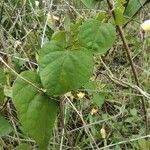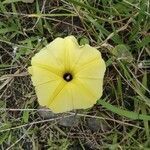Perennial; stems slender, prostrate or twining, pubescent to villous.. Leaf-blade ovate, up to 9 cm. long and 7.5 cm. wide, ± acuminate at the apex, cordate at the base, glabrescent or pubescent above, shortly pubescent beneath; petiole up to 8 cm. long.. Inflorescence 1–several-flowered, lax; peduncle slender, up to 5.5 cm. long; pedicels unequal, thickened above, 0.4–4 cm. long.. Sepals ovate, up to 6 mm. long and 3.7 mm. wide, acute, glabrous or pubescent.. Corolla yellow or white with a dark purple or brown centre, 2.7–4 cm. long, glabrous.. Capsule globose-conic, 12 mm. long, 10 mm. wide, glabrous, tipped by the hardened style-base.. Seeds brown, 5 mm. long.
Inflorescence 1-several-flowered lax; peduncle slender, up to 5·5 cm. long; pedicels unequal, up to 4 cm. long, shorter than the peduncle, thickened above; bracteoles minute, ovate, acuminate.
Leaf lamina cordate-ovate, up to 10 × 9 cm., acuminate at the apex, entire, membranous, glabrescent or pubescent above, shortly pubescent beneath; petiole up to 9 cm. long, slender.
Corolla funnel-shaped bright yellow or white, with a dark purple or brown centre, 2·7–5·5 cm. long, glabrous.
Stems slender, up to 5 m. long, prostrate or twining, pubescent, villous or subglabrous.
In typical specimens the corolla is 2·7-4 cm. long, bright yellow with a purple centre.
Capsule globose to conical, glabrous, tipped by the hardened style base.
Sepals ovate, up to 6 mm. long, acute, glabrous or pubescent.
Perennial herbaceous plant.
Seeds brown, pubescent.
A creeper.



